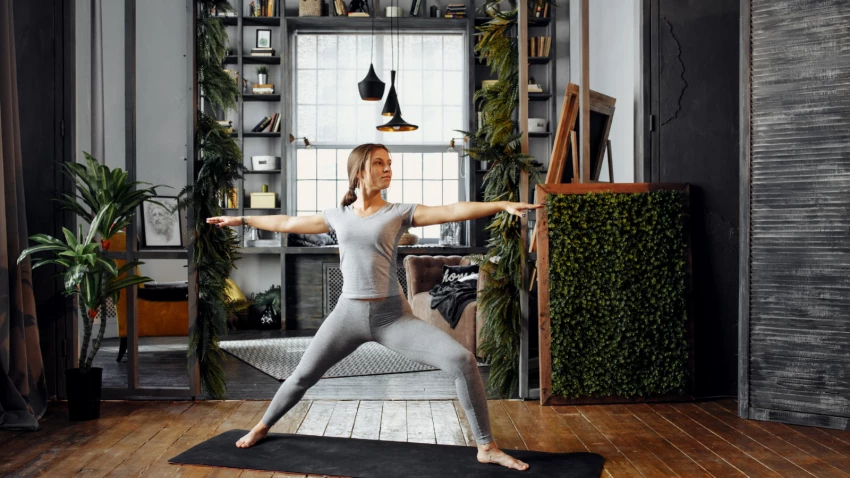Improve Your Agility with Yoga Practice

Agility is the ability to move easily through a series of positions while you stay balanced and in control. Everyday situations that require agility include getting in and out of a car (especially the back seat of a two-door!) and getting up and down from the floor. Often speed is required as well as coordination, such as when you walk down a crowded city sidewalk (have you ever been to New York City?) or scoop up a ball that’s rolling along the ground. For those of you who play sports, such as tennis, basketball, and soccer, maintaining agility will enhance your performance. Maintaining agility also helps prevent falls, a serious—sometimes life-threatening—problem for older people.
So even though we tend to think just about maintaining the ability to “balance” as we age, staying agile can be just as important both for our safety. Agility allows us to continue to do what we love, whether that’s participating in a sport, hiking in nature, or walking through the streets of a crowded city. So today I thought I’d provide an overview of what agility entails along with a list of the sequences on our blog that you can use to maintain and/or improve your agility.
4 Essential Elements of Agility

Being agile and coordinated requires a combination of a number of physical and mental skills. First of all, to move with ease, you need all three of the other essential skills that I hope you’re already working on strength, flexibility, and balance. To stay upright as you move from one position to another, the same postural reflexes that help you balance upright in static poses also help you stay upright when you’re moving from one position to another.
Exteroception and Proprioception
The ability to make coordinated, precise movements come from combining the three essential physical skills with knowing where you are in space. Exteroception is the ability to feel what is interacting with the exterior of your body. Proprioception is the ability to tell where one body part is in relation to another. Both allow you to maintain your balance in a static position. These same senses allow you to maintain your balance and sense of where your body is in space as you move from one position to another. So, both are as important for agility as they are for balance.
Vision, Hearing, and Touch
Whether you are walking down a crowded sidewalk during your lunch hour, hiking a mountain path, or doing Sun Salutations (Surya Namaskar) in a crowded classroom, you also need your eyes, ears, and sense of touch to tell you where you are in space, and to provide you with information about possible obstacles and your relationship to them. Is that someone riding a skateboard behind me? Is that a slippery rock in the middle of the path over there? Should I step back a bit so I don’t hit that person next to me when I bring my arms out to the sides? Or—oops—did I already do it?

Focus
Unless you’re doing a series of movements that have become automatic, your ability to concentrate as you move from one position to another is a very important aspect of agility. Becoming distracted can throw you off balance or cause you to run into an obstacle. Let’s say you’re at a music festival, weaving your way through the obstacle course of other people trying to find a good spot. There are blankets, chairs, and coolers set up by people already dug in and toddlers bolting off in random directions. If you stopped looking where you’re going or paying attention to where your feet were taking you, just imagine!
And even for a routine set of movements, such as Sun Salutations, some amount of mental focus is needed, as complete distraction causes you to lose track of where you are or suddenly find yourself doing the wrong thing (been there, done that).
Speed
For those times when you need to respond quickly and with coordinated movement, your strength is particularly important. Because the fast-twitch muscle fibers in your muscles affect the speed and explosiveness of your muscle contractions, strong muscles provide you with both power and velocity. But moving with speed on a regular basis will also prepare you for those situations when being agile means responding rapidly. In addition, a healthy somatic nervous system—the part of your nervous system that provides you with voluntary control of your body movements—is important for quick, coordinated responses to your requests for movement. When you think, “Step forward right foot,” you want fast results!
How to Create a Yoga Practice for Agility

A well-rounded yoga practice that cultivates strength, flexibility, and balance will also enhance your agility. But yoga enables you to work directly on the coordination and speed aspects of agility with the following:
Dynamic Poses and Flow Sequences
Moving dynamically in and out of poses with your breath or between linked poses in flow sequences allows you to practice quick, precise movements. This improves your overall coordination and exercises the fast-twitch fibers that assist in quick movements. The wide range of dynamic poses and flow sequences that you can choose from (and the ability to make up new ones!) provides enough variability to address virtually all your muscles and stay challenged.

Static Poses Improve Agility and Coordination
Moving in and out of static poses with precision helps improve coordination. Making subtle adjustments to your alignment while you’re in a pose refines your ability to sense where you are in space and improves fine motor control as you start to use rarely used muscles. The large repertoire of yoga poses, plus their many variations, means you can use virtually all your muscles—in many different ways—throughout a given week rather than just doing the same basic movements over and over.
To maintain your fast-twitch fibers, you can focus on strength-building practices in static poses, particularly standing poses that mimic getting up and down. Practicing all types of balance poses, especially using challenge techniques, such as varying the surface you practice on and standing poses with closed eyes, will also help maintain fast-twitch fibers and postural reflexes.
Floor Poses
Getting up and down from the floor on a regular basis helps you maintain agility (and it’s one of the things you need agility for!). So, just the act of adding floor poses to your practice is beneficial, even if you have to use support to get up and down.
Mindfulness
For all poses, practicing mindfully engages and refines your senses. For vision, you use your eyes to verify your alignment. Are your feet evenly aligned on the floor, or is your foot really turned out? For hearing, you use your ears to note how gracefully or awkwardly you make certain movements. For example, when you step into a new position, are you coming down lightly or heavily? For your sense of touch, you can observe how evenly you are pressing into the floor or onto a prop, and notice when one part of your body is touching another (sometimes that means you’re doing the pose right and other times—oops!).

Nerve Health
To maintain speed, you can use your asana practice to support the health of your somatic nervous system. Practicing a wide variety of poses and movement patterns will activate all those nerves on a regular basis. Active poses will improve blood flow to your special sensory nerve receptors (the nerves that shuttle information back to the brain), and stretching poses will create space around your nerves. Finally, balancing poses and flow sequences will help keep your proprioceptors—the nerves that allow you to sense where you are in space—healthy.
Mental Focus
Moving through flow sequences trains your mind as you return your focus repeatedly to making quick, precise movements while maintaining balance. You notice shifting sensations—the feeling of being on or off balance—and when extraneous thoughts take you away from your movements. In addition, breath practices and meditation can improve your mental focus, benefitting your balance inside and outside the yoga room.
Cognitive Distraction to Improve Agility
When you’re ready for more advanced challenges, you can prepare for real-world situations by adding cognitive distraction to your agility practices. Although you can’t toss a ball from hand to hand while practicing a flow sequence, you can play music, talk radio, or have some pets or small children—watch out!—join you in the yoga room.
Also, read...
Warrior I Pose: 5 Strengthening Variations
Deepening Your Home Yoga Practice: An Interview with Judith Hanson Lasater
4 Easy Ways to Use a Sandbag in Yoga Practice
Related courses
Breath as Medicine: Yogic Breathing for Vital Aging
Yoga and Myofascial Release: Releasing Chronic Tension with the Bodymind Ballwork Method

Nina Zolotow, RYT 500, Editor-in-Chief of the Yoga for Healthy Aging blog, is both a yoga writer and a yoga teacher. She trained to be a yoga teacher at The Yoga Room in Berkeley, California, has studied yoga therapy with Shari Ser and Bonnie Maeda, and is especially influenced by the teachings of Donald Moyer. She also studied extensively with Rodney Yee and is inspired by the teachings of Patricia Walden on yoga for emotional healing. Her special area of expertise is yoga for emotional well-being (including yoga for stress, insomnia, depression, and anxiety) and she teaches workshops and series classes on yoga for emotional well-being, stress management, better sleep, home practice, and cultivating equanimity. Nina is the co-author with Baxter Bell of Yoga for Healthy Aging: A Guide to Lifelong Well-Being and co-author with Rodney Yee of Yoga: The Poetry of the Body (with its companion 50 Card Practice Deck) and Moving Toward Balance. She is also the author of numerous articles on yoga and alternative medicine.



